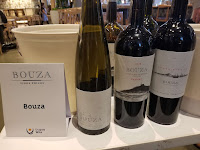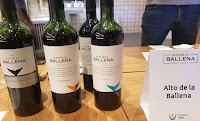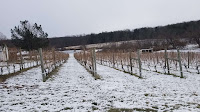We love receiving wines from
Domaine Bousquet, not only because of their quality and value, but also to learn more about regenerative farming. Their vineyards (first planted in 1997-98) are situated high above the clouds at 4,000 feet in Gualtallary in Mendoza’s Uco Valley. This dry environment definitely helped the winery achieve Regenerative Organic Certified (ROC)™ status -- only the fourth wine estate (and the first outside the U.S.).
"Regenerative organic agriculture is a collection of practices that focus on regenerating soil health and the full farm ecosystem. In practice, regenerative organic agriculture can look like cover cropping, crop rotation, low- to no-till, compost, and zero use of persistent chemical pesticides and fertilizers. Layered into these practices, depending on a farm’s needs, could be the addition of perennials, development of pollinator and wildlife habitats, incorporation of agroforestry systems, vegetative barriers, and other regenerative practices that are shown to contribute to the development of soil organic matter."

Domaine Bousquet Gaia Organic Cabernet Franc 2021 ($20)
The first tenant of regenerative farming is No-Till Farming. This method offers a range of benefits that can improve soil health, increase crop yields, reduce environmental impacts, and save farmers money. No-till farming educes soil erosion, preserves soil structure, increases soil organic matter, and reduces soil compaction, leading to better soil biological activity and improved soil health. Fields managed using no-till farming for multiple years have a higher water-holding capacity. And farmers benefit from reduces fuel and labor costs.
Grapes from the GAIA brand have always been grown organically and the "Greek goddess of the earth, has been the Bousquet family’s inspiration since founding our winery 1997". This 100% Cabernet Franc wine was aged in French oak between 8 and 10 months and shows luscious layers of dark fruit intertwined with earthy herbaceous notes.
Domaine Bousquet Gran Organic Cabernet Sauvignon 2021 ($25)
The next tenant of regenerative farming is
Biodiversity through at least four plant groups. This process increases pollinator populations by providing diverse flower-rich habitats and reduced pesticide use support pollinators like bees, butterflies, and hummingbirds. It enhances ecosystem services so that soil biota, decomposers, and predators work together to regulate pests and diseases, reducing the need for chemical controls. Biodiversity improves habitat connectivity as regenerative farms with diverse habitats and corridors can support wider species distributions and population growth. And is sequesters carbon as healthy soils and diverse ecosystems help sequester carbon, mitigating climate change and its impacts on biodiversity.
The Gran Domaine Bousquet label features the best grapes from the “home” vineyard – the original vineyard planted by Jean Bousquet in the late 1990s. The vines live in sandy soils and the grapes benefit from a dramatic diurnal temperature swing. The wine is aged 12 months in French oak lifting the fruit but allowing the layers of dark cherry and dried figs flavors to ride through the palate. The best food pairing: peppered beef jerky.
Domaine Bousquet Reserve Organic Cabernet Sauvignon 2022 ($18)
The third tenant of regenerative farming is planting
Cover Crops that become layers of armor by protecting the soil from sunlight and maintains moisture. Regenerative farming and cover crops are intertwined concepts that promote soil health, biodiversity, and ecosystem services. Regenerative agriculture focuses on enhancing natural processes to improve soil fertility, structure, and overall ecosystem function. Cover crops play a vital role in this approach, serving as a bridge between cash crops and soil regeneration.'
A step up from the premium varietal line, these blends of Domaine Bousquet 4,000-foot elevation estate-grown grapes from plots with low yields offer more of everything – more body, more tannin in the reds, and more flavor. The wine includes 15% Malbec and was aged 10 months in French oak. This is a wine to savor - layers of dark cherry fruit, traces of minerality and spice and a long lifting finish from the acidity and approachable tannins. Works well with chili.
Domaine Bousquet Alavida Kosher USDA-Certified Organic Cabernet Sauvignon 2022 ($18)
The fourth tenant of regenerative farming is incorporating
Animals as a key component to achieve the regenerative goals. This includes grazing management emphasizing rotational grazing, where animals are moved to different pastures to mimic natural grazing patterns. This approach promotes soil health, increases biodiversity, and sequesters carbon. Manure is used as a natural fertilizer, reducing the need for synthetic fertilizers and minimizing carbon emissions associated with their production and transportation. Animals like chickens, ducks, and geese can be used as natural pest managers, reducing the need for pesticides and promoting soil health. Holistic approach: Regenerative farming recognizes the interconnectedness of soil, plants, animals, and ecosystem services. By incorporating animals into the farming system, farmers can create a more resilient and diverse ecosystem.
The Alavida brand celebrates "to life!" which is the Spanish interpretation of the Hebrew toast l’chaim!. The brand also celebrates the diversity of Argentina and the multi-cultural family at Domaine Bousquet. In order for a wine to be designated Kosher ("fit or proper" ) handled throughout the production process by religious Jews under the guidance of a Rabbi. Thus the Domaine Bousquet team does not directly handle the production for this wine but based on the winery's unique style and technique. The winemaking team is in constant contact with the Rabbi and his team throughout the winemaking process. The grapes are hand harvested then fermented with selected yeast in stainless steel tanks. And according to the winery, "by not adding SO2, characteristics identified with the high-altitude, cool-climate terroir of Mendoza’s Uco Valley, are strengthened and enhanced. The purity of fruit, aroma, flavor, and freshness become yet more pronounced. Fruit has to be of superb quality, with great concentration, for the wine to remain stable without the presence of SO2. "
A juicy wine with layers of red fruit, distinct earthiness and minerality and lifting acidity. Definitely has a different character than the previous wines without the aging process. We paired it with the
Taza Wicked Dark Chocolate, but I can sea how others would prefer it with the
Sea Salt & Almond or
70% Deliciously Dark.
Domaine Bousquet Ameri Single Vineyard Organic Cabernet Sauvignon 2021 ($36)
The fifth and final tenant of regenerative farming is instituting
Labor Practices that ensure sufficient wages and worker safety. Regenerative farmers prioritize fair labor practices, ensuring decent working conditions, safe working environments, and equitable compensation for farmworkers. Regenerative agriculture values the dignity and well-being of farmers and farmworkers, recognizing their importance in maintaining healthy ecosystems and producing nutritious food. Regenerative farms strive to provide comfortable and safe working conditions, including adequate shade, ventilation, and access to clean water and sanitation facilities. Regenerative farmers avoid using synthetic pesticides, herbicides, and fertilizers, reducing exposure risks for farmworkers and promoting a healthier environment. Regenerative agriculture often involves community-based approaches, fostering relationships between farmers, farmworkers, and local communities to promote social and environmental sustainability. Regenerative farmers invest in training and capacity-building programs for farmworkers, enhancing their skills and knowledge in sustainable agriculture practices. Regenerative practices like agroforestry, cover cropping, and crop rotation can reduce labor requirements, improving working conditions and reducing the risk of labor exploitation. Regenerative farmers prioritize continuous learning and improvement, adapting to changing environmental and social conditions while refining their labor practices to ensure long-term sustainability.
Today Domain Bousquet is managed by founder's Jean Bousquet's son-in-law and daughter: Labid al Ameri & Anne Bousquet. al Ameri had joined his father-in-law full time in 2005 helping to build the winery while Anne joined the company in 2008. "In 2009, the couple moved to Tupungato full-time, assuming full ownership in 2011". The Ameri label is obviously named after co-owner Labid al Ameri and the grapes come from a single vineyard, located at 4,125 feet, the highest of the estate. These grapes are the last to be harvested. The wine is aged 12 months in French oak and shows blackberries and dark cherries, more intense minerality with traces of herbaciousness. Expect another long finish with layers of fruit and tannins.
 I am very embarrassed to admit that this was my first visit to Old House Vineyards, Distillery and Brewery. And Culpeper is only about an hour drive away. In any case, it was well worth the visit. Our group tasted through a flight of beer, wine, and had a very impressive lunch from their Green Ribbon Kitchen. Beef Bourguignon for me.
I am very embarrassed to admit that this was my first visit to Old House Vineyards, Distillery and Brewery. And Culpeper is only about an hour drive away. In any case, it was well worth the visit. Our group tasted through a flight of beer, wine, and had a very impressive lunch from their Green Ribbon Kitchen. Beef Bourguignon for me. The beer flight consisted of the Big Iron Lager, Harvest Ale 2025, Sunburnt Farmer, and Pure and Simple Stout. The later was excellent, served on Nitro, and paired nicely with the stew. The Harvest Ale 2025 was another standout brewed with 100% malted wheat and blended with Vidal Blanc pressings. Thus the vintage label. The Big Iron Lager is an American Pre-prohibition lager with more body than expected. I also wonder if a little rice makes it into the mash bill. Finally, the Sunburnt Farmer is an amber farmhouse house brewed with rye and wheat. Expect a very distinct profile.
The beer flight consisted of the Big Iron Lager, Harvest Ale 2025, Sunburnt Farmer, and Pure and Simple Stout. The later was excellent, served on Nitro, and paired nicely with the stew. The Harvest Ale 2025 was another standout brewed with 100% malted wheat and blended with Vidal Blanc pressings. Thus the vintage label. The Big Iron Lager is an American Pre-prohibition lager with more body than expected. I also wonder if a little rice makes it into the mash bill. Finally, the Sunburnt Farmer is an amber farmhouse house brewed with rye and wheat. Expect a very distinct profile.















































